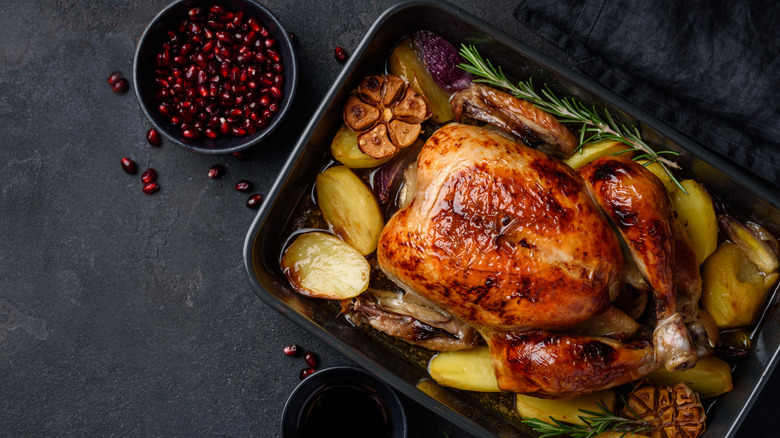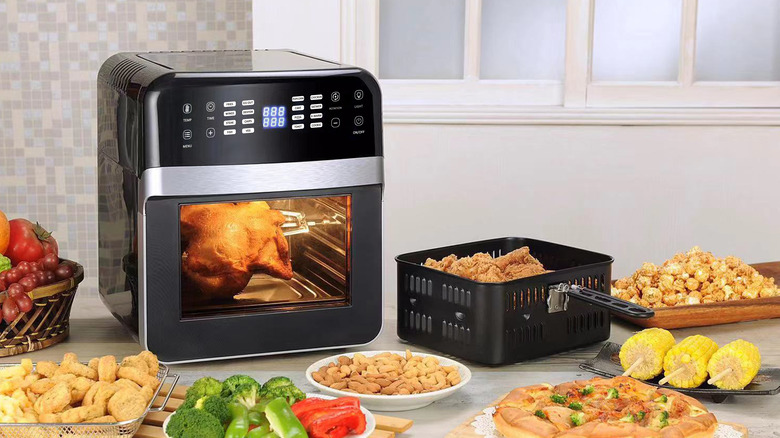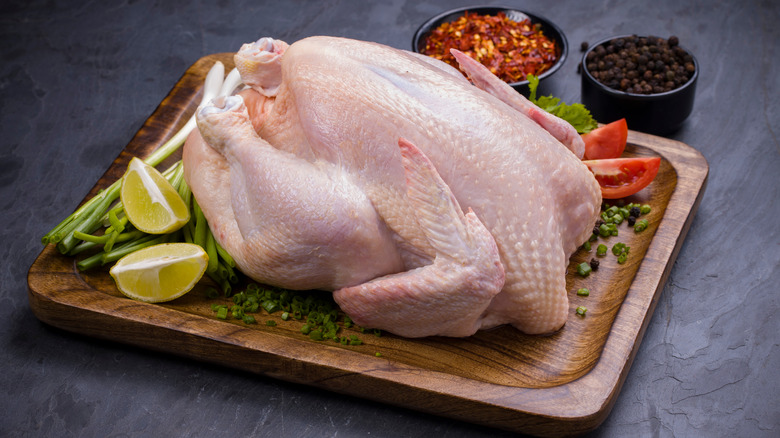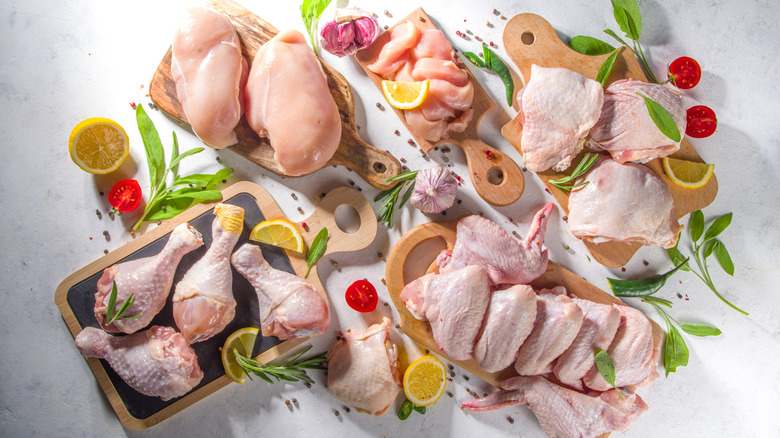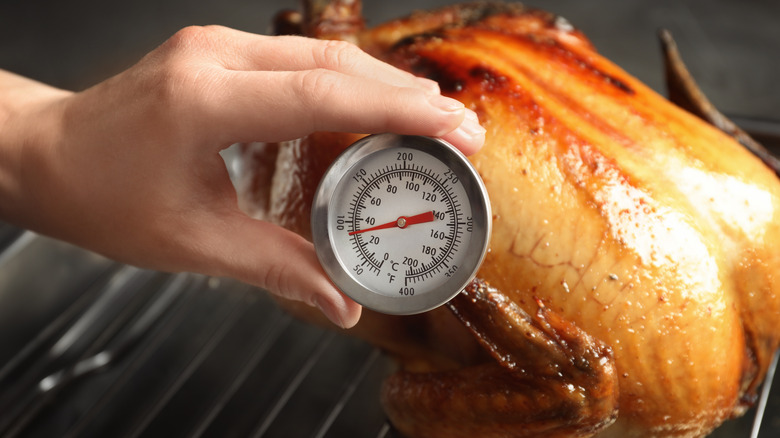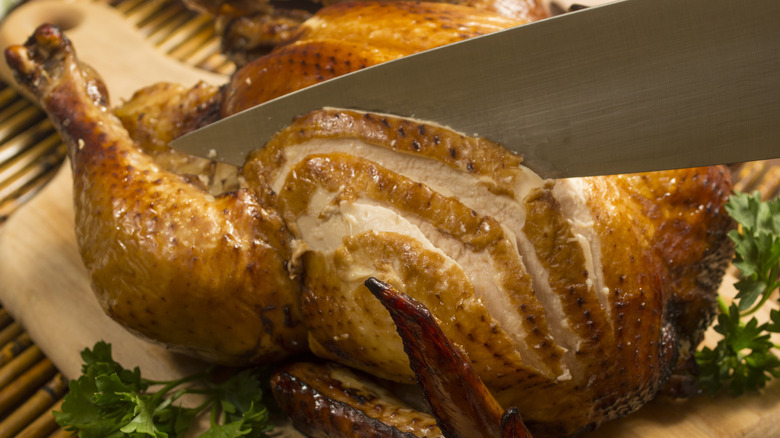The Best Temperature For Perfectly Cooked Chicken
Tender and succulent on the inside and golden and crispy on the outside, the inviting flavors of a perfectly cooked chicken are hard to resist. Used in a huge number of recipes, chicken is also generally healthier than pork, beef, and lamb since it has less saturated fat. As such, it's not surprising that chicken plays such a huge role in international cuisines. From French chicken cordon bleu to Indian chicken tikka masala, the versatile bird is a firm favorite across the globe.
No matter whether you are roasting a whole chicken or are in the mood for some tasty drumsticks, when it comes to poultry, getting the cooking process right is about much more than taste. This is because undercooked chicken can harbor pesky bacteria that can lead to serious gastrointestinal problems. Luckily, a little forethought can ensure that your poultry recipes aren't just delicious but also safe to put out on the dining table when guests visit for dinner.
The ideal internal temperature of mouth-watering chicken
According to the U.S. Department of Agriculture, the internal temperature of a perfectly cooked chicken is 165 degrees Fahrenheit (via CIDRAP). To cut a long story short, an undercooked chicken may not just be watery and pinkish but could give you a nasty case of food poisoning. An overcooked chicken, on the other hand, may turn out dry and stringy.
Some parts of a chicken, such as drumsticks and thighs, can be cooked until they reach a higher internal temperature to ensure optimal tenderness. A NACMCF report states: "Guidance to the consumer should indicate that higher final temperatures may be needed for consumer acceptability and palatability (e.g., 170°F for whole muscle breast meat, 180°F for whole muscle thigh meat in order to remove the pink appearance and rubbery texture)."
When it comes to the perfect internal temperature of chicken, the cut and cooking method matter. For example, roasting an entire chicken should take somewhere between an hour and an hour and a half, depending on the size of the bird and oven temperature.
Temper the chicken prior to cooking
While the slightly uneven temperature of a chicken breast may not make a whole lot of difference when it comes to the cooking process, this definitely isn't the case if you're cooking the entire chicken. This is because larger chunks of meat taken out of the fridge may be colder on the inside and warmer on the outside.
To ensure that meat is evenly cooked, it's essential to bring it to room temperature before it's cooked. This usually means keeping a cut of meat out on your tabletop for around 20 minutes and entire chickens for up to an hour. It should go without saying that leaving your poultry sitting on a kitchen bench overnight is a big no-no. After all, you don't want the meat to go off.
Never rinse raw chicken since this can spread bacteria across your kitchen and contaminate other food. Instead, pat the chicken dry with a paper towel. This will help ensure that the bird's skin gets nice and crispy as it cooks. In addition, trussing — or tying the drumsticks together before roasting — will keep them from becoming dry during the cooking process.
Don't overlook the cooking method and cut of chicken you're working with
Not all parts of a chicken should be cooked the same way. The times for cooking whole chickens, chicken legs, chicken breasts, and chicken wings are different. This is because they vary in shapes, sizes, and meat textures. In addition, cooking times should depend on the cooking technique, or whether you are roasting, stewing, or grilling your bird.
As a rule of thumb, the smaller the piece of meat and the higher the oven temperature, the less time it will take to cook all the way through. No matter what part of a chicken you are cooking, be sure that it reaches the prescribed internal temperature of 165 degrees Fahrenheit.
According to the United States Department of Agriculture, the roasting time for 4-to 8-ounce chicken thighs or drumsticks at 350 degrees Fahrenheit should be between 40 and 50 minutes. For 4-ounce boneless breast halves, the same process should take between 30 and 35 minutes. Meanwhile, drumsticks should be roasted at 350 degrees for between 35 and 45 minutes (via MasterClass).
How to tell that the chicken is thoroughly cooked
The most reliable way of checking whether a chicken is cooked is by tracking its internal temperature with a meat thermometer. Instant-read thermometers should always be placed in the area of the meat that takes the longest to cook. When it comes to entire chickens, this is under the breast or the meaty part of the thigh. Be sure not to insert the thermometer near a bone or into fat or gristle as this may produce inaccurate results.
While using meat thermometers is by far the best way of ensuring that a chicken has reached the desired internal temperature, there are also some more traditional means of checking the state of your dinner. Firstly, as a general rule, chicken meat needs to stay in the oven for 15 minutes for every pound of its weight. You can also cut into a chicken between the thigh and breast areas. If the meat is white and the juice clear — rather than pinkish — your bird is ready to eat. Another way to ensure a properly cooked chicken is to test it with your finger. Cooked chicken feels firm while raw chicken feels rubbery.
The right temperature stops foodborne illnesses
Let's face it, there is a good reason why restaurant menus don't feature chicken carpaccio or chicken tartare. Undercooked chicken can harbor salmonella and campylobacter. And, yes, both of these can make you very sick, leaving you with diarrhea, stomach pains, and even fever.
The Centers for Disease Control and Prevention (CDC) reports that around 1.3 million Americans are affected by salmonella each year leading to 26,500 hospitalizations. While not all of these cases are connected to undercooked chicken, CDC estimates that around 1 million people in America get sick after eating contaminated poultry annually.
Luckily, bacteria in chicken can be eradicated at the right temperature. A perfectly cooked chicken should be at least 165 degrees Fahrenheit all the way through. This is the best temperature to ensure that the meat is not only tender but also free of harmful microbes. But this isn't all. It's recommended that raw chicken be stored in the fridge at 40 degrees Fahrenheit or lower for no longer than two days. If not cooked in this period of time, be sure to freeze the bird to prevent it from going bad.
